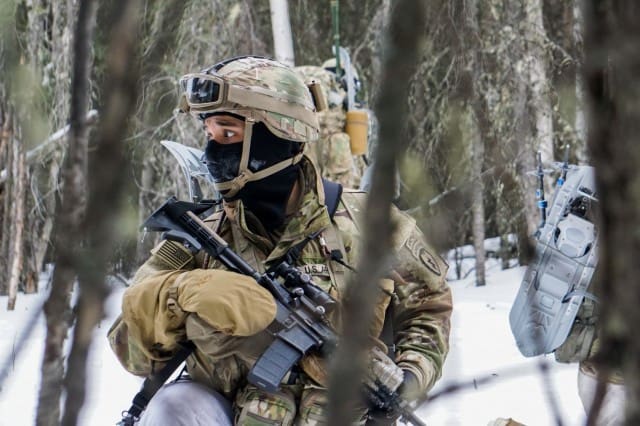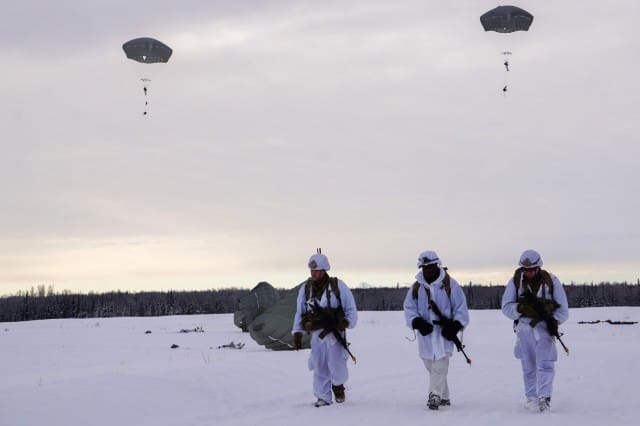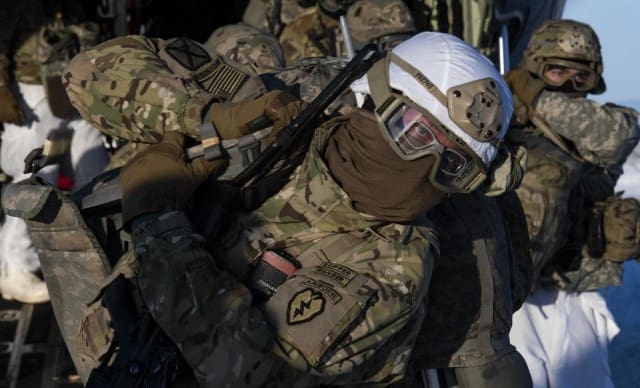JOINT BASE ELMENDORF-RICHARDSON, Alaska – Paratroopers of the 4th Infantry Brigade Combat Team (Airborne), 25th Infantry Division, “Spartan Brigade,” began a six month-long study on Joint Base Elmendorf-Richardson, Alaska, using wearable technology to study the resiliency of soldiers operating in an Arctic environment, Jan. 11, 2020.

The Spartan Brigade contracted with wearable technology company WHOOP and scientists from the University of Queensland to conduct a 6-month study of nearly 1,000 paratroopers. Paratroopers use the real-time data provided by the WHOOP straps and accompanying mobile phone application to measure their daily strain and recovery rates while training in extreme Arctic winter conditions.
“The rigors of Arctic airborne operations take a toll on the human body,” said Col. Chris Landers, the Spartan Brigade commander. “How do we maximize a paratrooper’s effectiveness on the battlefield while dealing with extreme cold and lack of sunlight?”
As the only airborne infantry brigade combat team in the Arctic theater, the Spartan Brigade paratroopers conduct airborne operations in sub-freezing temperatures, during high winds, and with minimal hours of sunlight.

“We’re called on by our nation to respond with little notice to contingencies around the globe,” said Landers. “We don’t choose the time or the place, but we can choose how well we perform when we get there.”
Using adjustable wrist straps, the study captures biometric data on each volunteer participant throughout the workday and while they’re sleeping, providing an analysis of their exertion, heart rate behavior, and sleep quality, all of which is used to determine overall strain and recovery.
Unlike blind studies, the paratroopers participating in this study will each have immediate access to their own data through the accompanying mobile application, and can make decisions using this feedback to improve their personal performance.
“We are empowering our paratroopers to better understand themselves,” said Command Sgt. Maj. Alex Kupratty, the Spartan Brigade command sergeant major. “This study is all about putting the power of technology and data directly into their hands, so they can truly harness their own potential.”

Paratroopers will also be provided educational blocks to teach them techniques to maximize their recovery. Partway through the study, a section of participants will be asked to concentrate on three habits: creating a cold, dark space for sleeping; not eating after 7pm, and sticking to a rigid sleep time schedule.
“The goal of the study is twofold,” said Chief Warrant Officer 4 Phillip Ranck, study project leader for the Spartan Brigade. “First, that soldiers gain a better understanding of themselves. Second, that soldiers understand that their leaders are taking an aggressive approach to understanding the impacts of training and the Arctic environment’s impact on their mental and physical health.”
Participants can also sign up for social groups, adding a competitive incentive within their peer groups as they compare their strain and recovery numbers every day.
“The goal is to give our paratroopers the data and education to shape the conversations among their peers about their daily fitness and health,” said Kupratty. “Not only do they better understand their own bodies, but they’re building lifelong, healthy habits along the way.”
All leaders from the squad level and up will have access to their paratroopers’ data, so they can adjust training and operational plans to maximize the health and potential of their teams.
“Imagine as a squad leader that you have a paratrooper that has had an abnormally low recovery for several days,” said Kupratty. “Maybe your platoon has been in the field for weeks, or the paratrooper just returned from an Army school. Now you have the data to better help them recover, or to adjust your training to match the team’s needs.”
According to some researchers, fluctuations in someone’s recovery rate may indicate a buildup of social or personal stressors that can lead to decreased motivation or resiliency, or the development of an illness like influenza or COVID-19.
“This is all about better understanding what a soldier needs to be the best version of themselves as fast as possible,” said Kupratty.
The study is organized by the brigade’s digital technology innovation cell, SPARwerx. The SPARwerx initiative crowdsources innovators from across the brigade to develop internal technologies, systems, and concepts to maximize the welfare, safety and efficiency of Spartan paratroopers.
By MAJ Jason Welch


“All leaders from the squad level and up will have access to their paratroopers’ data, so they can adjust training and operational plans to maximize the health and potential of their teams.”
The potential for micro- and mismanagement is boundless.
So this is like a fit-bit…just better analytics? In reading this I couldn’t help but laugh at the idea of Soldiers wearing these on their off hours…4/25 was constantly on the blotter when I was at JBER, I guess now squad leaders would be able to track joes at the bar or something.
In all honestly and snarkiness aside, I think it is good to be able to assess bio data in an arctic or desert environment but think the flood of information would be paralyzing to a normal unit. Instead, alerts would be helpful as a risk mitigation tool potentially.